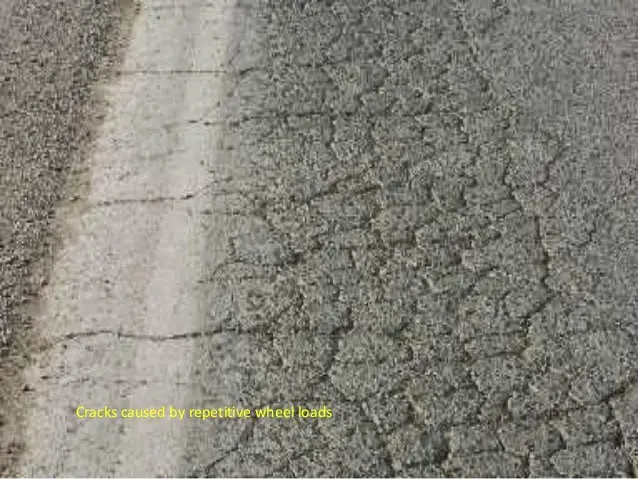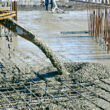The fatigue failure of a pavement consists of 4 states as;
Initiation of minor hairline cracks
Development of micro cracks into wider macroscopic cracks
Propagation of these cracks across the thickness of pavement
Development of Pothole and ultimate premature failure of pavement
 |
| Fatigue Failure leading to Development of Pothole |
Fatigue cracking is sometimes also called alligator cracking, as they resembles the shape of the skin of an alligator due to the interconnectedness of the micro cracks in asphaltic pavements. Factors influencing the fatigue cracks
Factors affecting Fatigue cracking
There are numerous factors that influence the development of alligator cracks, some of them can be number and magnitude of applied loads, the structural design of pavement including the type of layer materials and thicknesses of various layers, the quality and uniformity of foundation support, How much workable or consistent is the asphalt cement used, the quantity and quality of the asphalt, the presense of air voids and characteristics of the asphalt concrete mix and the last one can be the temperature or the climate condition of the site under consideration.
Problems due to Fatigue Cracking
Due to fatigue cracking there are numerous problems to be faced by the pavement if not proper maintenance is ensure, the structure failure is at the top having, moisture infiltration, roughness and development of pothole are further worse situation inter-related to fatigue cracking.
Causes of Fatigue Cracking
Despite of the fact that fatigue stresses are directly caused because of traffic loading but the factors that can make the situation more worse are the environment factors including weather.
Similarly due to moisture or any other reason when the subbase or base of the pavement is weakened the pavement will not be able to handle more loads and thus failure would occur.
Sometimes when the drainage characteristics of pavement is not properly optimized the bed of the road degraded causing base or sub-base weakness.
Sometimes due to poor adhesion between the asphalt and the aggregates, the aggregates started to dislodge from the surface this process is called stripping or raveling due to this exercise same result of fatigue cracking can be observed.
Fatigue Cracking and Edge Cracking
 |
| Alligator Cracking (Fatigue cracking) |
( function() { if (window.CHITIKA === undefined) { window.CHITIKA = { \’units\’ : [] }; }; var unit = {\”calltype\”:\”async[2]\”,\”publisher\”:\”smsbazaar\”,\”width\”:550,\”height\”:250,\”sid\”:\”Chitika Default\”}; var placement_id = window.CHITIKA.units.length; window.CHITIKA.units.push(unit); document.write(\’
\’); }());
Sometimes there is confusion between the edge cracking and fatigue cracking. Both of these are not similar, the basic difference between edge cracking and fatigue cracking is that edge cracking starts from surface and propagate downwards where as fatigue cracking starts from bottom and propagate to the surface.
Presentation of Fatigue Cracking
As we now, know the reasons of fatigue cracking we can easily prevent them, by making sure the pavement have sufficient resistance against the causing factors, these my include,
Lowering or reducing the load on asphalt pavement by increasing the thickness of the pavement.
Provide adequate drainage at the ends and shoulders to avoid collection of water there as well as its percolation into the body of pavement which may worsen the situation.
How to repair Fatigue Cracking
Similarly like presentation, in repair work one must know the reason of fatigue cracks, but sometimes the specific cause is fairly difficult to determine, and prevention is there correspondingly difficult. Any investigation should involve digging a pit which means coring of the pavement body to determine the structural makeup of the pavement as well as determining whether or not subsurface moisture is a contributing factor.
While the fatigue crack is in its early stage, crack sealant may heal the bad effects and avoid further damage of the road, but ultimately the crack will propagate and failure will be unavoidable at the end only one solution exists and that is to do overlay of the cracked pavement by a hot Mix asphalt (HMA) of sufficient strength to resist the loading effects.
According to the conclusion from some of the laboratory tests one can say; for thin asphalt concrete layers which are less than 5 inches, asphalt cement of low stiffness or low viscosity should be used to avoid premature failure due to fatigue, and thus for the asphalt concrete layer of 5 and more than 5 inch thick asphalt cement of high stiffness should be used.















